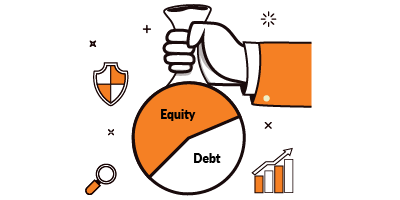What is Balanced Fund?
Balanced funds or Balanced Hybrid Funds are a type of hybrid fund. They are open-ended balanced schemes investing in both equity and debt instruments. As per SEBI regulations, these funds have to invest 40%-60% of assets in equity and 40-60% of the assets in debt securities. Also, SEBI doesn’t allow arbitrage in these funds. These funds aim to strike a stability between capital appreciation and safety against potential risks through equity and debt, respectively. They are less vulnerable to market fluctuations than pure equity funds.
Balanced funds invest in both equity and debt asset classes in varying proportions based on the type of hybrid fund. The six different types of hybrid funds include conservative hybrid fund, balanced hybrid fund, aggressive hybrid fund, dynamic asset allocation fund (balanced advantage fund), multi-asset allocation fund, equity savings fund, and arbitrage fund. Few hybrid funds invest in equities more than debt to take the opportunity of the market movements. In contrast, few invest in debt securities more to provide a safety cushion. They are less vulnerable to market fluctuations than pure equity funds.
Popular Balanced Funds to Invest in 2025
- HDFC Balanced Advantage Fund
- SBI Balanced Advantage Fund
- ICICI Prudential Balanced Advantage Fund
- Edelweiss Balanced Advantage Fund
- Kotak Balanced Advantage Fund
- Mirae Asset Balanced Advantage Fund
- Parag Parikh Conservative Hybrid Fund
- Tata Balanced Advantage Fund
Types of Balanced Funds
The following are the types of balanced funds:
- Equity-oriented balanced fund: Equity-oriented funds invest at least 65% of their assets in equity and equity-related instruments. The remaining portion is in debt securities.
- Debt-oriented balanced fund: Debt-oriented funds invest at least 65% of their assets in debt securities such as fixed-income securities – T-bills, bonds, debentures, etc.
How Do Balanced Funds Work?
Balanced funds, a type of hybrid funds, invest in both equity and debt securities. They aim at capital appreciation as well as stability of returns through a safety net. A fund manager of a these fund invests in both equity and debt securities in varying proportions and takes advantage of market movements.
The fund manager aims at generating high returns through equity components and at the same time, ensures a safety cushion against extreme market fluctuations through debt components. These funds portfolio is diverse. It invests across equity and debt asset classes.
When investors invest money in a balanced fund, it is invested based on market situations. If the markets are high, then the majority of the assets are invested in debt securities. And if the market is undervalued, then the assets are invested in equities. Once the money is invested, the asset allocation changes as per the market fluctuations.
Advantages of Balanced Funds
The following are the advantages of investing in balanced mutual funds:
- Diversification: Balanced mutual funds are an ideal investment option that exposes you to both equity and debt. These funds offer diversification that helps minimise the risk and simultaneously ensures capital appreciation.
- Re-balancing of Funds: It is quite difficult to predict the markets. Sometimes, the equity market may be overvalued and sometimes, the debt market. Balanced funds give the fund manager the liberty to navigate the holding between debt and equity. As a result, the fund manager can balance the fund’s portfolio and performance to tackle market fluctuations.
- Lower Risk: Compared to a pure equity scheme, balanced funds have a lower risk. This is because of the debt competent that helps balance out the market volatility of the equity component.
- Protection from Inflation: Balanced funds invest across both debt and equity. The equity portion helps generate inflation-beating returns, while the debt portion generates stable income. As a result, these funds are suitable options for hedging against inflation.
- Tax Implications: The capital gains from balanced funds depend on the type of balanced fund orientation. Equity-oriented balanced funds are taxed like equity mutual funds. While debt-oriented funds are taxed like debt funds.
- Equity-Oriented Balanced Funds: When the holding period is less than 1 year, the short-term capital gains are taxable at 15%. When the holding period is greater than 1 year, the long-term capital gains above INR 1,50,000 are taxable at 10%.
- Debt-Oriented Balanced Funds: When the holding period is less than 3 years, the short-term capital gains are taxable at the applicable income tax slab rate. When the holding period is greater than 3 years, the long-term capital gains are taxable at 20% with an indexation benefit.
Are Balanced Mutual Funds Safe?
No investment is a safe investment, and none guarantee returns. Mutual fund investments are subject to market volatility. Hence, balanced funds are not completely safe. The investments are subject to market volatility. These funds are relatively safer than equity funds, but they are riskier than debt funds.
These funds invest across both equity and debt investment. Hence they are benefiting from stock price appreciations and interest from debt investment.
Historical performance of these funds has been significant. Also, the long term returns from the best funds have been around 15%. However, none of these facts justifies that they are safe.
Therefore, like any investment scheme, these funds also gave certain characteristics that investors shouldn’t overlook. It is important to note that these funds invest a significant portion of their corpus in equities. Hence, making them volatile investments.
Difference Between a Balanced Fund and Balanced Advantage Fund
A balanced fund is a type of hybrid fund that invests in equal proportion in equity and debt. As per SEBI regulations, these funds have to invest 40%-60% of assets in equity and 40%-60% of the assets in debt securities. The fund doesn’t permit arbitrage. On the other hand, balanced advantage fund is a type of hybrid fund where the investment in equity and debt is managed dynamically. If the markets go up, the exposure in equity falls, and exposure to debt rises. And if the markets go down, the exposure to equity rises, and exposure to debt falls.
Balanced advantage funds are multidimensional. When markets are high exposure in equity falls and can protect the portfolio against volatility. Similarly, when the markets are low, a balanced advantage fund has scope to increase equity exposure and earn higher returns. On the other hand, a balanced fund won’t offer much protection against volatility, nor can it increase equity exposure to more than 60% to earn higher returns.
Since balanced advantage funds use dynamic asset allocation, there is no need to time the market. However, for balanced funds, one needs to enter after proper research about valuations and favourability of the market.
Difference Between Equity and Balanced Funds
Balanced funds are investment options that invest in both stocks and bonds. The fund juggles equity and debt exposure depending on market conditions. Another name for these funds is hybrid funds. These funds aim to provide investors with modest capital appreciation with lower volatility. Also, all balanced funds are not the same. The equity composition in the fund is the differentiator. For example, funds with greater exposure to small and mid-cap companies tend to be more volatile. Additionally, the composition of the debt securities affects the alpha. For example, debt securities with good or high credit ratings are more stable in comparison to securities with low ratings.
On the other hand, equity funds invest majorly in stocks. The percentage of equity exposure ranges between 65% – 80%. The funds invest the remaining minor percentage in other securities like debt. Except for thematic funds, all equity funds have a well-diversified portfolio. Equity funds are suitable for the long term horizon. Therefore, investors seeking to achieve long term goals such as, savings for a child’s education or buying a home or retirement can invest in equity mutual funds. However, at the same time, they should be willing to undertake the volatility associated with equity investments.
You may also like to read about Balanced Fund Vs Equity Fund
Equity oriented balanced funds have similar taxation of pure equity funds.
The long term capital gains (LTCG) above INR 1,00,000 are taxable at 10%. LTCG is for investments that investors hold beyond one year. While, for investments withholding period of less than one year, attract short term capital gains (STCG) tax of 15%.
Debt oriented balanced funds are taxable like debt funds. Till March 31st 2023, investments with a holding period of more than three years attract LTCG of 20% with indexation benefit. For gains from investments held for less than three years, are taxable as per the investor’s income tax slab rate.
As per the Finance Bill 2023, from April 1st 2023, the capital gains from debt fund investments are taxed as per the investor’s income tax slab rate. The LTCG benefit has been removed for debt mutual funds.
Discover Popular Funds
- What is Balanced Fund?
- Popular Balanced Funds to Invest in 2025
- Types of Balanced Funds
- Confused if your portfolio is performing right enough to meet your goals?
- How long have you been investing in mutual funds?
- What is your current portfolio size?
- What is your approximate annual household income?
- Your profile does not qualify for a call with a Financial Expert.
- How Do Balanced Funds Work?
- Advantages of Balanced Funds
- Are Balanced Mutual Funds Safe?
- Difference Between a Balanced Fund and Balanced Advantage Fund
- Difference Between Equity and Balanced Funds
























Show comments